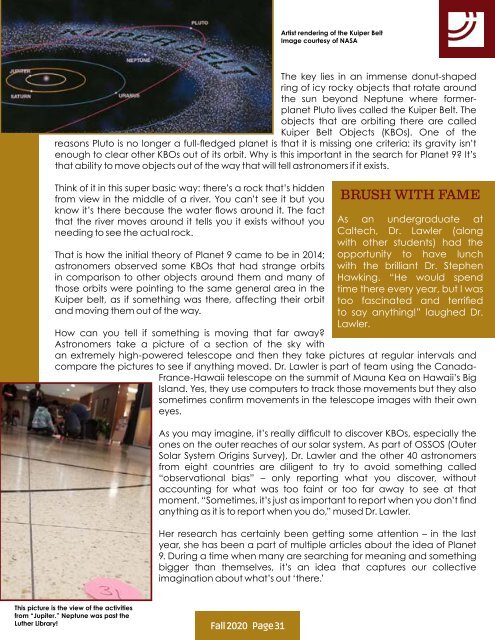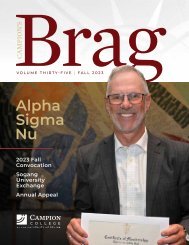Brag-Fall2020
You also want an ePaper? Increase the reach of your titles
YUMPU automatically turns print PDFs into web optimized ePapers that Google loves.
Artist rendering of the Kuiper Belt<br />
Image courtesy of NASA<br />
The key lies in an immense donut-shaped<br />
ring of icy rocky objects that rotate around<br />
the sun beyond Neptune where formerplanet<br />
Pluto lives called the Kuiper Belt. The<br />
objects that are orbiting there are called<br />
Kuiper Belt Objects (KBOs). One of the<br />
reasons Pluto is no longer a full-fledged planet is that it is missing one criteria: its gravity isn’t<br />
enough to clear other KBOs out of its orbit. Why is this important in the search for Planet 9? It’s<br />
that ability to move objects out of the way that will tell astronomers if it exists.<br />
Think of it in this super basic way: there’s a rock that’s hidden<br />
from view in the middle of a river. You can’t see it but you<br />
know it’s there because the water flows around it. The fact<br />
that the river moves around it tells you it exists without you<br />
needing to see the actual rock.<br />
That is how the initial theory of Planet 9 came to be in 2014;<br />
astronomers observed some KBOs that had strange orbits<br />
in comparison to other objects around them and many of<br />
those orbits were pointing to the same general area in the<br />
Kuiper belt, as if something was there, affecting their orbit<br />
and moving them out of the way.<br />
BRUSH WITH FAME<br />
As an undergraduate at<br />
Caltech, Dr. Lawler (along<br />
with other students) had the<br />
opportunity to have lunch<br />
with the brilliant Dr. Stephen<br />
Hawking. “He would spend<br />
time there every year, but I was<br />
too fascinated and terrified<br />
to say anything!” laughed Dr.<br />
Lawler.<br />
How can you tell if something is moving that far away?<br />
Astronomers take a picture of a section of the sky with<br />
an extremely high-powered telescope and then they take pictures at regular intervals and<br />
compare the pictures to see if anything moved. Dr. Lawler is part of team using the Canada-<br />
France-Hawaii telescope on the summit of Mauna Kea on Hawaii’s Big<br />
Island. Yes, they use computers to track those movements but they also<br />
sometimes confirm movements in the telescope images with their own<br />
eyes.<br />
As you may imagine, it’s really difficult to discover KBOs, especially the<br />
ones on the outer reaches of our solar system. As part of OSSOS (Outer<br />
Solar System Origins Survey), Dr. Lawler and the other 40 astronomers<br />
from eight countries are diligent to try to avoid something called<br />
“observational bias” – only reporting what you discover, without<br />
accounting for what was too faint or too far away to see at that<br />
moment. “Sometimes, it’s just as important to report when you don’t find<br />
anything as it is to report when you do,” mused Dr. Lawler.<br />
Her research has certainly been getting some attention – in the last<br />
year, she has been a part of multiple articles about the idea of Planet<br />
9. During a time when many are searching for meaning and something<br />
bigger than themselves, it’s an idea that captures our collective<br />
imagination about what’s out ‘there.’<br />
This picture is the view of the activities<br />
from “Jupiter.” Neptune was past the<br />
Luther Library!<br />
Fall 2020 Page 31

















